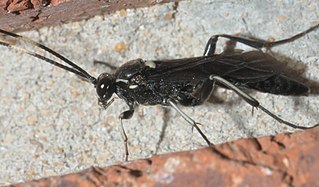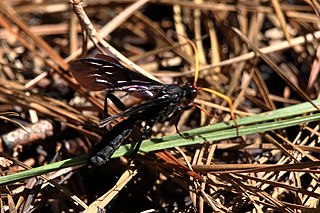
The superfamily Ichneumonoidea contains one extinct and three extant families, including the two largest families within Hymenoptera: Ichneumonidae and Braconidae. The group is thought to contain as many as 100,000 species, many of which have not yet been described. Like other parasitoid wasps, they were long placed in the "Parasitica", variously considered as an infraorder or an unranked clade, now known to be paraphyletic.

The Ichneumonidae, also known as ichneumon wasps, ichneumonid wasps, ichneumonids, or Darwin wasps, are a family of parasitoid wasps of the insect order Hymenoptera. They are one of the most diverse groups within the Hymenoptera with roughly 25,000 species described as of 2016. However, this likely represents less than a quarter of their true richness as reliable estimates are lacking, along with much of the most basic knowledge about their ecology, distribution, and evolution. It is estimated that there are more species in this family than there are species of birds and mammals combined. Ichneumonid wasps, with very few exceptions, attack the immature stages of holometabolous insects and spiders, eventually killing their hosts. They play an important role as regulators of insect populations, both in natural and semi-natural systems, making them promising agents for biological control.

The Braconidae are a family of parasitoid wasps. After the closely related Ichneumonidae, braconids make up the second-largest family in the order Hymenoptera, with about 17,000 recognized species and many thousands more undescribed. One analysis estimated a total between 30,000 and 50,000, and another provided a narrower estimate between 42,000 and 43,000 species.

The Metopiinae are a worldwide subfamily of the parasitic wasp family Ichneumonidae. Metopiinae are koinobiont endoparasitoids of Lepidoptera. There are 26 extant genera. A bulging shield-like face is diagnostic for members of this subfamily, but many members lack this character.

Ichneumoninae is a worldwide subfamily of the parasitic wasp family Ichneumonidae.

A wasp is any insect of the narrow-waisted suborder Apocrita of the order Hymenoptera which is neither a bee nor an ant; this excludes the broad-waisted sawflies (Symphyta), which look somewhat like wasps, but are in a separate suborder. The wasps do not constitute a clade, a complete natural group with a single ancestor, as bees and ants are deeply nested within the wasps, having evolved from wasp ancestors. Wasps that are members of the clade Aculeata can sting their prey.
Habronyx minutus is a species of small parasitic wasp in the subfamily Anomaloninae of family Ichneumonidae. It has a length of 5.5 to 8 millimetres. The species was described by D. F. Ward in 2015, and the holotype was collected in December 1980 at Pelorus Bridge.

Megarhyssa macrurus, also known as the long-tailed giant ichneumonid wasp or long-tailed giant ichneumon wasp, is a species of large ichneumon wasp. It is a parasitoid, notable for its extremely long ovipositor which it uses to deposit an egg into a tunnel in dead wood bored by its host, the larva of a similarly large species of horntail.

Trogus is a genus of parasitoid wasp found in the Holarctic and Neotropic regions. It is placed in the subfamily Ichneumoninae and the tribe Ichneumonini. Trogus species are parasites of larvae and pupae of the swallowtail butterfly family, Papilionidae. The genus consists of twelve extant and one extinct species.

Ichneumonini is a tribe of ichneumon wasps in the family Ichneumonidae. There are more than 350 genera and thousands of described species in Ichneumonini.
Lathrolestes luteolator is a species of wasp in the family Ichneumonidae. It is native to North America and is a parasitoid of various species of sawfly larvae. In the 1990s, it started to parasitise the larvae of the invasive amber-marked birch leaf miner in Alberta. When this pest spread to Alaska, the wasp was used in biological pest control.

Acrodactyla quadrisculpta is a species of parasitoid wasp belonging to the family Ichneumonidae.
Diaparsis is a genus of parasitoid wasps belonging to the family Ichneumonidae.

Diphyus is a genus of parasitoid wasps belonging to the family Ichneumonidae.
Tranosema is a genus of parasitoid wasps belonging to the family Ichneumonidae.
Rhembobius is a genus of parasitoid wasps belonging to the family Ichneumonidae. They are parasitoids of pupal stage Syrphidae.
Heterischnus is a genus of parasitoid wasps belonging to the family Ichneumonidae.
Allomacrus is a genus of parasitoid wasps belonging to the family Ichneumonidae.

Gnamptopelta obsidianator is a species of wasp in the family Ichneumonidae and the only species in the monotypic genus Gnamptopelta.

Colpotrochia is a genus of ichneumon wasps in the family Ichneumonidae. There are at least 61 described species in Colpotrochia.













